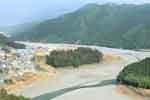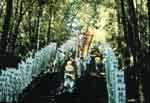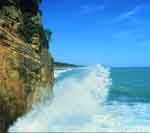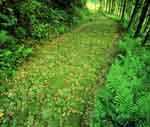Healing - Experience - From Hongu To Shingu Old road (No.3)
Healing - Experience -
Nakaheji
Old road (No.1)
Healing -
Experience - Okumotori,
Kogumotori Old road (No.2)
Healing -
Experience - Kumano
Kaido Old road (No.4)
 Oyunohara is the original site of the Hongu
Shrine. It is here where the divinities of the Hongu
shrine actually reside. Only two small stone shrines
remain after the original shrine was destroyed by flood
waters. Even though the main shrine was moved to higher
ground there is a strong and tangible spiritual power
here. It is said that one can become rejuvenated just by
being on this spot for a short time.
Oyunohara is the original site of the Hongu
Shrine. It is here where the divinities of the Hongu
shrine actually reside. Only two small stone shrines
remain after the original shrine was destroyed by flood
waters. Even though the main shrine was moved to higher
ground there is a strong and tangible spiritual power
here. It is said that one can become rejuvenated just by
being on this spot for a short time.  At Oyunohara, especially in the early morning,
you can feel the unique spiritual energy of this place.
Before the big flood in 1898 it was famous for its large
number of shrines and buildings spreading over the whole
area.
At Oyunohara, especially in the early morning,
you can feel the unique spiritual energy of this place.
Before the big flood in 1898 it was famous for its large
number of shrines and buildings spreading over the whole
area.
to the top
 The Kumano Hongu Grand Shrine is one of the
Three Kumano Grand Shrines. Branches of this shrine,
called 'Kumano Jinja', can be found all over Japan. The
Kumano Hongu Shrine has a very long history, and used to
be located on an island in the Kumano River where it was
washed away by a big flood in 1898.
The Kumano Hongu Grand Shrine is one of the
Three Kumano Grand Shrines. Branches of this shrine,
called 'Kumano Jinja', can be found all over Japan. The
Kumano Hongu Shrine has a very long history, and used to
be located on an island in the Kumano River where it was
washed away by a big flood in 1898.  After
the flood, the shrine was moved to its present location
halfway up a nearby hill. A stone path consisting of 130
steps leads to the shrine. The new shrine is said to be
only one eighth the size of the original shrine.
After
the flood, the shrine was moved to its present location
halfway up a nearby hill. A stone path consisting of 130
steps leads to the shrine. The new shrine is said to be
only one eighth the size of the original shrine.
to the top
 Ohama is the name of a beach which stretches
from the mouth of Kumano River along the southeast edge
of Shingu City toward Nachi. Ohama is also known as
Ojigahama' (Oji Beach) due to the fact that Hama Oji
Shrine, one of the Kumano Tsukumo Oji Shrines, can be
found there. After a long journey pilgrims, from both the
Nakaheji Route and the Ise Route, would stop to worship
at the Hayatama Grand Shrine. On the way to Nachi from
Hayatama pilgrims would also stop to pray at the many Oji
Shrines along the way. to the top
Ohama is the name of a beach which stretches
from the mouth of Kumano River along the southeast edge
of Shingu City toward Nachi. Ohama is also known as
Ojigahama' (Oji Beach) due to the fact that Hama Oji
Shrine, one of the Kumano Tsukumo Oji Shrines, can be
found there. After a long journey pilgrims, from both the
Nakaheji Route and the Ise Route, would stop to worship
at the Hayatama Grand Shrine. On the way to Nachi from
Hayatama pilgrims would also stop to pray at the many Oji
Shrines along the way. to the top
 A plateau pushes itself out onto Ojigahama Beach
and the beach becomes a rocky shoreline of sheer cliffs.
This section of the shoreline is called Mitarai Kaigan
which is famous as a place for Shiogori (Seawater
Purification). It only lasts for a few hundred meters,
but it is so steep and rocky that it is constantly
pounded by great waves making it impossible to traverse.
Kumano Kodo Old Road therefore followed the beach only
until this point then avoided this section by winding its
way up onto the plateau and crossing over to the other
side where the beach again becomes walkable.
A plateau pushes itself out onto Ojigahama Beach
and the beach becomes a rocky shoreline of sheer cliffs.
This section of the shoreline is called Mitarai Kaigan
which is famous as a place for Shiogori (Seawater
Purification). It only lasts for a few hundred meters,
but it is so steep and rocky that it is constantly
pounded by great waves making it impossible to traverse.
Kumano Kodo Old Road therefore followed the beach only
until this point then avoided this section by winding its
way up onto the plateau and crossing over to the other
side where the beach again becomes walkable.  After Ojigahama, The Kumano Kodo Old Road climbs
up to a plateau called Koyanosaka. From Koyanosaka, you
can catch sight of the Pacific Ocean as it spreads out
before your eyes. Koyanosaka is the only place in Shingu
City where the old stone pathway can still be found. One
can also find the ruins of an old resthouse built long
ago with the support of Seigoin, the main shrine of
Mountain Buddhism. You can also see the ruins of the
Hirotsuno milestone, and a stone statue of the
Boddhisatva along the way. Walking along this section of
the Old Road you can let your imagination drift into the
golden age of Kumano when these paths were frequented by
thousands of pilgrims on their way to the Nachi Grand
Shrine.
After Ojigahama, The Kumano Kodo Old Road climbs
up to a plateau called Koyanosaka. From Koyanosaka, you
can catch sight of the Pacific Ocean as it spreads out
before your eyes. Koyanosaka is the only place in Shingu
City where the old stone pathway can still be found. One
can also find the ruins of an old resthouse built long
ago with the support of Seigoin, the main shrine of
Mountain Buddhism. You can also see the ruins of the
Hirotsuno milestone, and a stone statue of the
Boddhisatva along the way. Walking along this section of
the Old Road you can let your imagination drift into the
golden age of Kumano when these paths were frequented by
thousands of pilgrims on their way to the Nachi Grand
Shrine.
| Back to Previous Page | Go to Next Page | Back to Experience-Healing Home | Go to Main Menu |